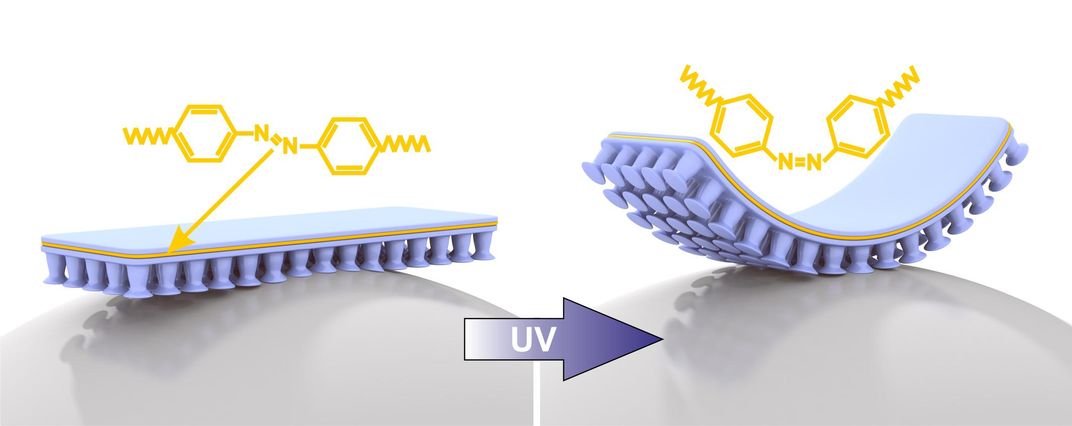Scientists Can Turn This Gecko-Inspired Gripping Device On or Off With the Flick of a Light
The mighty lizard inspires yet another innovation that could prove a boon to robotics and manufacturing
/https://tf-cmsv2-smithsonianmag-media.s3.amazonaws.com/filer/d9/58/d9584ce4-0184-47a1-a20b-40c3794a5956/dae4th_1.jpg)
Geckos are downright inspiring. Not only are these reptiles cute, colorful and adept at selling car insurance—but their super-stickiness has been perplexing humans for millennia. Thanks to adhesive feet and a keen manipulation of molecular bonds, geckos are able to climb vertical walls with ease, and can even hang upside down from surfaces. Now, their sticky limbs have inspired a new device that could help (Humans? Robots? Would like a noun here) pick up and drop things with the switch of a light.
The prodigious powers of gecko feet have mystified scientists until about 15 years ago. That’s when researchers learned that these animals exploited the relatively weak Van der Waals force to adhere themselves to surfaces and remove themselves with ease. Unlike a stronger magnetic force, the Van der Waals force results from the imbalance in charges between different molecules, creating a loose attraction. By using millions of miniscule hairs on their feet—each of which can orient in a certain direction and be attracted by the Van der Waals force—geckos can create a powerful but also reversible adhesive force.
Five years ago, Kiel University zoologist Stanislav Gorb used the insights on gecko hair to create a silicone tape so strong that a 64-square-inch piece of it was able to easily hold a full-sized adult hanging from a ceiling. Unlike normal tape, it could also be detached and reattached multiple times without losing its stickiness. In late 2015, Gorb's work helped lead to the commercialization of "gecko tape." Though the product has found limited use so far, it can be found in a brand of Canadian horseback riding pants to help riders stay in their saddles, and has found an enthusiastic investor in PayPal founder Peter Thiel.
But figuring out what made gecko feet so sticky only solved half the problem.
"Animals do not only attach, but they also [detach] by using these adhesive structures," says Emre Kizilkan, a Ph.D. student studying materials engineering at Kiel University. All geckos need to do is angle their foot or even just the hairs themselves differently and the foot will lift away, for example. Working under Gorb, Kizilkan wanted to replace the muscular movements used by geckos to control their stickiness with some sort of “switch” that humans could easily exploit. Her solution: Light.
After all, light is a free, clean energy source that can be easily controlled from a distance. This makes it “very suitable for precise micromanipulation,” Kizilkan says.
Using the already commercially available gecko tape, Kizilkan attached the tape to a film of liquid crystalline elastomers—a substance made of polymer chains that elongate when exposed to ultraviolet light. The elongation pulls the artificial gecko tape hairs into a position where they lose their attraction. The tape then detaches from whatever it was sticking to, according to an article published last week in the journal Science Robotics.

In videos created by the researchers, their "bioinspired photocontrollable microstructured transport device" (BIPMTD) was able to pick up glass plates and even test tubes and drop them easily after a UV light shined on it.
"This material can do two things together," Kizilkan says: both stick and release. He envisions light-activated gecko tape being a boon to delicate lab work, industrial manufacturing and possibly even for robots to transport materials. As just one example, it could be used to carry toxic chemicals in a test tube and drop them safely in another area without any human hands involved. Or, it could allow someone to scale a wall with only gecko tape and a light. Rescue robots could one day use the technology to climb into damaged buildings and save people.
Collaborator Anne Staubitz, a biochemist at the University of Bremen, hopes to work in the future on modifying the BIPMTD to use longer, less damaging wavelengths of light, and hopefully move forward on developing a product in the next few years.
Stanford University engineering researcher Mark Cutkosky, who was not involved in this research, recalls seeing gecko-inspired adhesion controlled by magnetic, electrostatic, and other forces, but this is the first use of light he's seen. While he likes seeing the new development and the potentials it brings, Cutkosky says he would like to see more tests of the durability of the BIPMTD and how well it can scale up to the large forces and weights that would be used in robotics and manufacturing.
Aaron Parness, a NASA Jet Propulsion Laboratory robotics researcher, has helped design gecko-inspired gripping technology that astronauts could use to mount sensors and walk across spacecraft without bulky harnesses. Parness agrees with Cutkosky on the challenges that the BIPMTD would need to overcome.
"Ten years ago, we all thought that making the gecko inspired material was the biggest challenge—and it was a very big challenge—but in the past few years it has become clear that the mechanisms we use to take advantage of the gecko-inspired materials’ properties are also a very big challenge," says Parness, who was not involved in this research. "It's another system by which we can realize the great potential of the gecko-inspired adhesives."